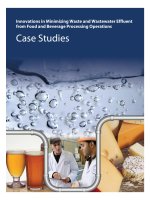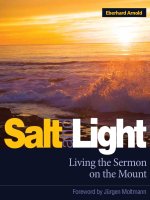- Trang chủ >>
- THPT Quốc Gia >>
- Hóa
Energy from heat and light
Bạn đang xem bản rút gọn của tài liệu. Xem và tải ngay bản đầy đủ của tài liệu tại đây (3.13 MB, 10 trang )
Genre
Nonfiction
Comprehension Skill
Compare and
Contrast
Text Features
•
•
•
•
Captions
Charts
Diagrams
Glossary
Science Content
Light and Heat
Scott Foresman Science 6.18
ISBN 0-328-14022-8
ì<(sk$m)=beac a< +^-Ä-U-Ä-U
Vocabulary
conduction
conductor
convection
heat
insulator
radiation
reflection
refraction
thermal energy
Picture Credits
Every effort has been made to secure permission and provide appropriate credit for photographic material.
The publisher deeply regrets any omission and pledges to correct errors called to its attention in subsequent editions.
Photo locators denoted as follows: Top (T), Center (C), Bottom (B), Left (L), Right (R), Background (Bkgd).
Opener: Mark Romanelli/Alamy Images; 5 (TR) Mark Romanelli/Alamy Images; 6 (T) Willie Sator/Alamy Images;
9 (T) Tom Vezo/Nature Picture Library; 13 (TR) Digital Vision.
Unless otherwise acknowledged, all photographs are the copyright © of Dorling Kindersley, a division of Pearson.
ISBN: 0-328-14022-8
Copyright © Pearson Education, Inc. All Rights Reserved. Printed in the United States of America.
This publication is protected by Copyright, and permission should be obtained from the publisher prior to any
prohibited reproduction, storage in a retrieval system, or transmission in any form by any means, electronic,
mechanical, photocopying, recording, or likewise. For information regarding permission(s), write to
Permissions Department, Scott Foresman, 1900 East Lake Avenue, Glenview, Illinois 60025.
3 4 5 6 7 8 9 10 V010 13 12 11 10 09 08 07 06 05
What did you learn?
1. What is thermal energy?
2. What is radiation?
3. What are some examples of insulators?
4.
Two types of waves are
transverse waves and compressional waves. Write
to explain the difference between them. Include
details from the book to support your answer.
5.
Compare and Contrast Explain how
conduction and convection are alike and
by L. L. Owens
how they are different.
Heat
Transferring
Thermal Energy
Thermal Energy
Thermal energy is the total kinetic
and potential energy of the particles in
a substance. If you could see the particles
in steam you would see that they move
quickly. The particles that make ice might
not appear to be moving, but they are.
In fact, all matter is made up of particles
that are always moving. The energy that
results from the movement is called
kinetic energy.
Particles in a solid have a small
amount of kinetic energy. That energy
causes them to vibrate, but the particles
cannot move from their fixed position.
Particles in a liquid have more kinetic
energy. They can flow around each other.
Particles in a gas can move freely. They
have even more kinetic energy than
particles in a liquid. Particles in a
substance always pull on each other.
They have potential energy, which is
stored energy due to position.
Thermal energy is affected by
temperature. A cool cup of water has
more potential energy than the same size
cup of warm water. The warm water has
more kinetic energy because particles
move faster at a higher temperature.
2
gas particles
If you have ever taken your temperature, you’ve measured
your own kinetic energy. A thermometer measures the average
kinetic energy of particles in your body, which is your
temperature. Temperature and thermal energy are not the same
thing. Recall that thermal energy is the total kinetic and potential
energy. Temperature is a measure of the average kinetic energy.
It does not depend on how much of a substance there is.
Heat is the transfer of thermal energy from one substance
to another. It always moves from a warmer substance to a cooler
one. When something gets warmer, that means thermal energy has
moved into it. You see this when you toast a slice of bread. The
energy from the toaster moves into the bread and warms it up. It
causes the average kinetic energy of the bread’s particles to rise.
The thermal energy from the toaster
moves into the slices of bread.
liquid particles
solid particles
All matter is made up
of particles that are
always moving.
3
ice cubes
Conduction
Convection
There are three types of transfer:
conduction, convection, and radiation.
Conduction is the transfer of thermal
energy between two objects that touch.
An example is ice cubes dropped into a
glass of water. The water has a higher
temperature, so its particles are vibrating
faster than those in the ice. When the
cooler ice touches the warmer water, the
water’s particles bump against the particles
in the ice. The ice particles start moving
faster. Energy transfers from the water to
the ice. Conduction has made the water
cooler and the ice particles warmer.
Conduction does not cause the particles
in the substances to change location.
Instead, energy moves from particle to
particle. This happens as the particles bump
against each other.
It can occur between
a warmer object and a
cooler one. It can occur
between the warmer
part of an object and
a cooler part of the
same object.
Thermal energy can
also be transferred by
convection. Convection is
the transfer of thermal
energy by the movement of a
Hang gliders soar on
fluid. A fluid is any gas or liquid.
convection currents.
When fluids are heated, they become
less dense. This causes warm fluids to rise above
cooler, more dense ones. Cool fluids sink. When warm fluids rise,
they carry their thermal energy with them, and can then transfer
that energy to other materials.
The rising and sinking of fluids often occurs in circular
patterns called convection currents. Huge convection currents
are generated in Earth’s atmosphere, causing wind. Warm land
transfers thermal energy up into the atmosphere. There energy
is transferred to the cooler surrounding air. When the air cools
enough, it sinks back to Earth. It rushes in under other air that is
being heated by the land. This cycle happens over and over again.
Thermal energy moves
from the liquid to the ice
by conduction.
4
As hot water rises
from the bottom
of the pan,
thermal energy
is transferred by
convection.
5
Insulation
Crocodiles are cold-blooded and need
to absorb energy from the Sun.
Radiation
Radiation is the transfer of thermal energy as waves. This
transfer can happen through matter or across empty space. In the
picture above, energy from the Sun warms the crocodile through
radiation. Solar energy travels to Earth through space. Some solar
radiation is absorbed into Earth’s surface. The absorbed radiation
causes Earth’s surface to become warm.
Some solar radiation is reflected back toward space. But
gases in the atmosphere can also cause it to be reflected back
to Earth’s surface again. This is known as the greenhouse
effect. The greenhouse effect is crucial to the survival
of life on Earth. Without it, Earth would be cold and
lifeless. Scientists study whether the greenhouse effect
causes such gases as carbon dioxide to trap too much
radiation. The concern is that the unnecessary
radiation makes Earth’s climate warmer.
6
The process of insulation helps stop or
reduce energy transfer. A heavy winter coat
acts as an insulator because it is made of
material that does not easily transfer thermal
energy. It can help keep you warm on a cold
day. On the other hand, a metal flagpole will
feel very warm when it’s hot outside. Metal
is a conductor, so it easily transfers
thermal energy.
Let’s take a closer look at insulators
and conductors. Remember that particles
in a warmer object move faster than
particles in a cooler object. What happens
if the two objects touch? The particles in
the warmer object bump against the
particles in the cooler object. This causes
the particles in the cooler object to start
moving faster. The kinetic energy rises.
Conduction causes the temperature of
the cooler object to rise.
Clothes insulate us
against the cold.
The Greenhouse Effect
Some solar radiation
bounces between the
surface of Earth and
gases in the atmosphere.
Pollution causes gases to build
up in the Earth’s atmosphere.
These gases trap solar radiation
and make Earth’s climate hotter
and hotter.
7
Silver and copper are two metals that are good conductors.
Electrons in these metals are not tightly held to the atoms.
These electrons can move easily. They can carry energy from
place to place. If you have ever felt the handle of a metal spoon
that is in a bowl of hot soup, then you have experienced
conduction. The handle feels warm because thermal energy
from the hot soup was transferred into the spoon, and when
you touched it, heat moved into your hand.
If the particles of a material do not easily transfer energy,
that material is an insulator. The particles in fluids are farther
apart. This makes fluids better insulators than solids. Empty
space is another example of an insulator. Energy can only
move through empty space by radiation.
Metal objects, such as this
spoon, conduct heat well.
Polar bears have a thick
layer of fat and fur, which
acts as an insulator against
frigid weather.
Use of Insulators
Insulators are an important part of
fiberglass
daily life. You may put extra blankets on
foam
your bed if it is cold. Layers keep you warm.
Air is a good insulator, so the pockets of
air between the layers keep you warm.
Animals living in cold climates have their
own insulation to help them get through
the harshest conditions. They may have
thick layers of fat or fur that trap thermal
energy and keep it close to their bodies.
Insulation helps buildings stay at a
comfortable temperature. You may have
seen insulating materials such as fiberglass,
carpet, double-layer windows, and foam
used in your own home. The many layers
carpet
of insulation contain air pockets that slow
the movement of thermal energy out of
double-layer window
the home. This is important on cold winter
days. In warmer weather, the insulation
Houses are built using
keeps thermal energy out of the house.
insulating materials, which
slow the movement of thermal
energy in and out of the house.
8
9
How Waves
Carry Energy
transverse wave
Striking the fork causes its molecules
and the surrounding air to vibrate. The
vibrations move outward in all directions
through the air. When they reach your ear,
you hear a sound. Sound waves can travel
through matter, but they can’t travel
through empty space.
gamma rays
X rays
ultraviolet rays
compressional
wave
Kinds of Waves
Many types of energy move in waves. There are two
main types of waves: compressional and transverse. Both
move through matter, but they do not carry the particles
of the matter along with them. In compressional waves,
the particles move back and forth, like the folds of an
accordion. In transverse waves, they move up and down,
like a cork bobbing on an ocean wave.
Vibrations cause all waves, including
sound waves. Sound is an important type
of compressional wave. Have you ever seen
someone use a tuning fork? It’s made up of a
handle and only two tines, or teeth. When
you strike the tuning fork, the tines
vibrate and produce a specific pitch.
Tuning forks always
produce a certain pitch.
10
Electromagnetic
Spectrum
Light travels as a wave. Unlike sound,
light can travel through empty space. One
of the many types of waves that travel
from the Sun to Earth is visible light.
Wavelengths can be long or short. The
electromagnetic spectrum is the pattern
you would get if you arranged all types
of waves from the shortest wavelength
to the longest. As wavelengths become
longer, frequencies become lower.
A shorter wavelength indicates that
a wave has more energy.
visible light
infrared rays
microwaves
radio waves
The electromagnetic spectrum
arranges waves according to
frequency and wavelength.
11
Refraction
translucent
transparent
opaque
Light cannot travel through all objects. Some
materials take in or absorb light, while some
materials let some or all light pass through.
Light Absorption
If you were to shine a flashlight on a window, would the light
travel through the glass? Yes! Would the same light travel through
a metal door? No. Light reacts differently when it travels through
different types of matter. Some light is taken in or absorbed by
matter. Some of this light energy is converted to thermal energy.
Dark-colored materials absorb more light energy than light-colored
materials. A black car sitting in hot sunlight will feel warmer than a
white car will. Darker objects absorb more light energy and convert
it into thermal energy.
Almost all light passes through transparent materials, such as
glass and water. Less light passes through translucent materials such
as waxed paper. No light passes through opaque materials such as
rock and metal.
The speed of light is 300,000 kilometers per second. That’s
the speed at which all electromagnetic waves travel through empty
space. Light travels through matter at slower speeds, and those
speeds vary. Light travels the fastest through gases. It moves slower
through liquids and slowest through solids.
12
Refraction is the change in
direction of light as it moves from
one material to another. Light changes
speed as it moves through different
materials. If a light beam strikes the
border of two materials at an angle,
this will change the speed. The change
in speed then changes its direction.
An example of refraction is when
a ray of sunlight hits a glass prism.
The light is made up of various
wavelengths. It appears to be
colorless. But when it enters the
prism, the light changes direction.
The different wavelengths refract at
a variety of angles and give off a
rainbow effect. In fact, that is exactly
what happens when it is raining and
the Sun comes out again. Where it is
still raining, some of the raindrops
act like little prisms. Light from the
Sun refracts at various angles, and
you can see a rainbow!
Raindrops act like little
prisms and split light
into different colors.
A prism splits white light
into different colors.
13
The Color of Things
Have you ever thought about why you see things in color?
The color of any object depends on the wavelengths of light
that it absorbs and reflects.
A mirror’s smooth
surface allows light
to reflect back.
A black object absorbs almost all the light
that hits it. When you look at a black bowling
ball, very little light reflects back to your eyes.
White is made up of a
combination of all wavelengths of
light. This white dog reflects almost
all of the light that hits him.
Reflection
The bouncing of light rays off a material’s surface is called
reflection. Reflection happens when light does not pass through
a material and it also is not absorbed. A mirror’s smooth surface
allows light to reflect back so you can see your image, or your
reflection. You can also see your reflection in some other
smooth-surfaced materials.
Surfaces such as walls, tabletops, and book covers appear to
be smooth, but do not reflect well enough for you to see a reflection.
If you look very closely at them, you will see that their surfaces
contain bumps and holes. Light bounces off of these surfaces in
many different directions. For you to see your reflection, a surface
must be so smooth that light bounces back to your eyes.
14
When you look at a red apple, you see
the red light that reflects off it. Red objects
absorb all light wavelengths except red.
Green objects, such as this clover, absorb
all light wavelengths except green. That means
they reflect the green wavelengths of light.
These blue gloves reflect only
blue wavelengths of light. All other
wavelengths of light are absorbed.
15
Vocabulary
Glossary
conduction
conductor
conduction
convection
heat
insulator
conductor
radiation
reflection
refraction
convection
thermal energy
heat
the transfer of thermal energy between
two objects that touch
1. What is thermal energy?
2. What is radiation?
a material that easily transfers thermal
energy
the transfer of thermal energy by the
movement of a fluid
3. What are some examples of insulators?
4.
Two types of waves are
transverse waves and compressional waves. Write
to explain the difference between them. Include
details from the book to support your answer.
5.
Compare and Contrast Explain how
conduction and convection are alike and
how they are different.
thermal energy that moves from one
substance to another
insulator
a material that does not easily transfer
thermal energy
radiation
the transfer of thermal energy as waves
reflection
the bouncing of light rays off a surface
refraction
the change in direction of light when it
moves from one material to another
Picture Credits
Every effort has been made to secure permission and provide appropriate credit for photographic material.
The publisher deeply regrets any omission and pledges to correct errors called to its attention in subsequent editions.
thermal energy
the total kinetic and potential energy of
the
particles in a substance
Photo locators denoted as follows: Top (T), Center (C), Bottom (B), Left (L), Right (R), Background (Bkgd).
Opener: Mark Romanelli/Alamy Images; 5 (TR) Mark Romanelli/Alamy Images; 6 (T) Willie Sator/Alamy Images;
9 (T) Tom Vezo/Nature Picture Library; 13 (TR) Digital Vision.
Unless otherwise acknowledged, all photographs are the copyright © of Dorling Kindersley, a division of Pearson.
ISBN: 0-328-14022-8
Copyright © Pearson Education, Inc. All Rights Reserved. Printed in the United States of America.
This publication is protected by Copyright, and permission should be obtained from the publisher prior to any
prohibited reproduction, storage in a retrieval system, or transmission in any form by any means, electronic,
mechanical, photocopying, recording, or likewise. For information regarding permission(s), write to
Permissions Department, Scott Foresman, 1900 East Lake Avenue, Glenview, Illinois 60025.
3 4 5 6 7 8 9 10 V010 13 12 11 10 09 08 07 06 05
16
What did you learn?









